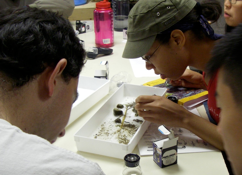Education
Citizen Scientists offers volunteers a variety of in-class training workshops and education sessions as well as hands-on field experience. We also work with partners and other agencies to provide volunteers with other environmental educational experiences. Some of our sessions and other educational experiences include:
Ontario Stream Assessment Protocol
Using the Ministry of Natural Resources (MNR) Ontario Stream Assessment Protocol we provide training for volunteers by certified OSAP crew leaders and other trained volunteers that have had previous years of field experience. Volunteers will learn to identify and set up stream monitoring sites, collect stream morphology information,
learn proper data recording procedures, and conduct benthic invertebrate, fisheries
and temperature monitoring.
Fish and Benthic Invertebrate Identification
Presentations and workshops are given to volunteers to help them learn how to identify local species of fish and benthic macroinvertebrates.
Ecological Analysis
Presentations are given to assist volunteers in the understanding of what environmental and ecological data can be used for and how to interpret what it means.
Redside Dace Research
We assist the Toronto and Region Conservation Authority (TRCA) and the University of Toronto (UofT) in habitat research on this locally endangered minnow species.
Click here for more information about this research and to view a video of redside dace spawning activity.
Project Crayfish
Developed by the Toronto Zoo, Project Crayfish is a collaborative effort aimed at understanding the status of crayfish in Ontario. Our volunteers helped in the development of the crayfish identification guide and ongoing work continues with the Toronto Zoo to provide crayfish information to the project.
For more information about Project Crayfish click here.
To view a copy of the Crayfish Identification Guide click here.
Vernal Pools
Once a year we co-ordinate a guided hike with the Ontario Vernal Pool Association (OVPA) to learn about vernal pool habitats and their ecological importance.
Click here to see photos from our 2008 hike with OVPA.
Click here to learn more about OVPA.










